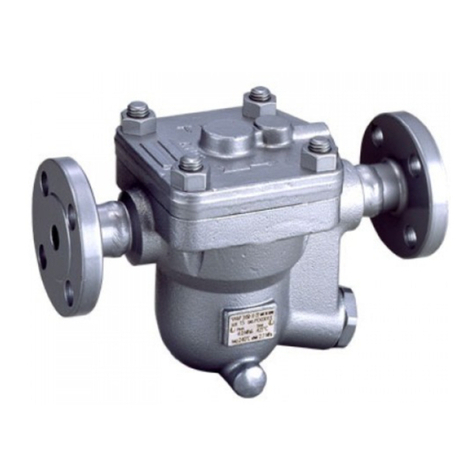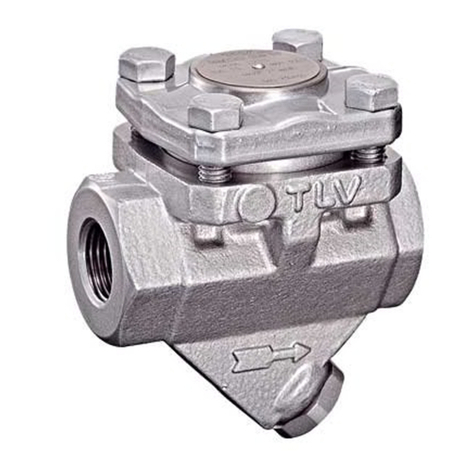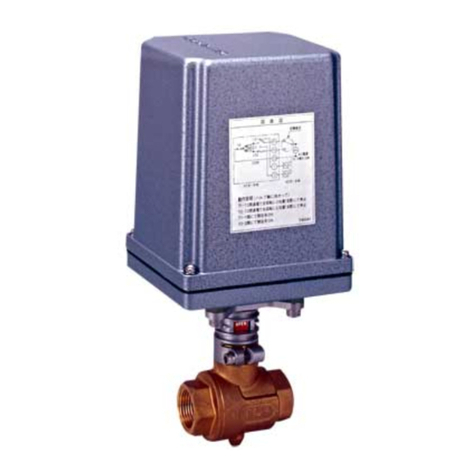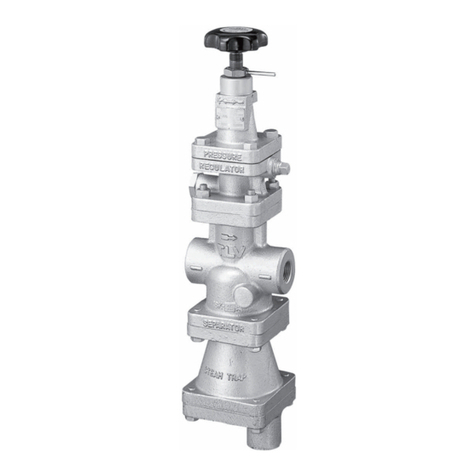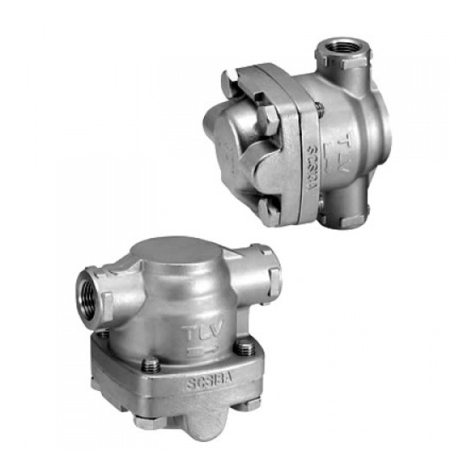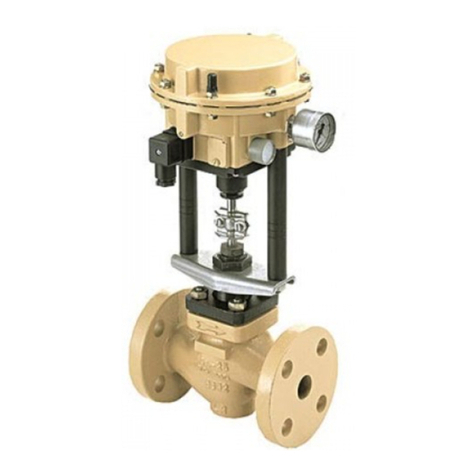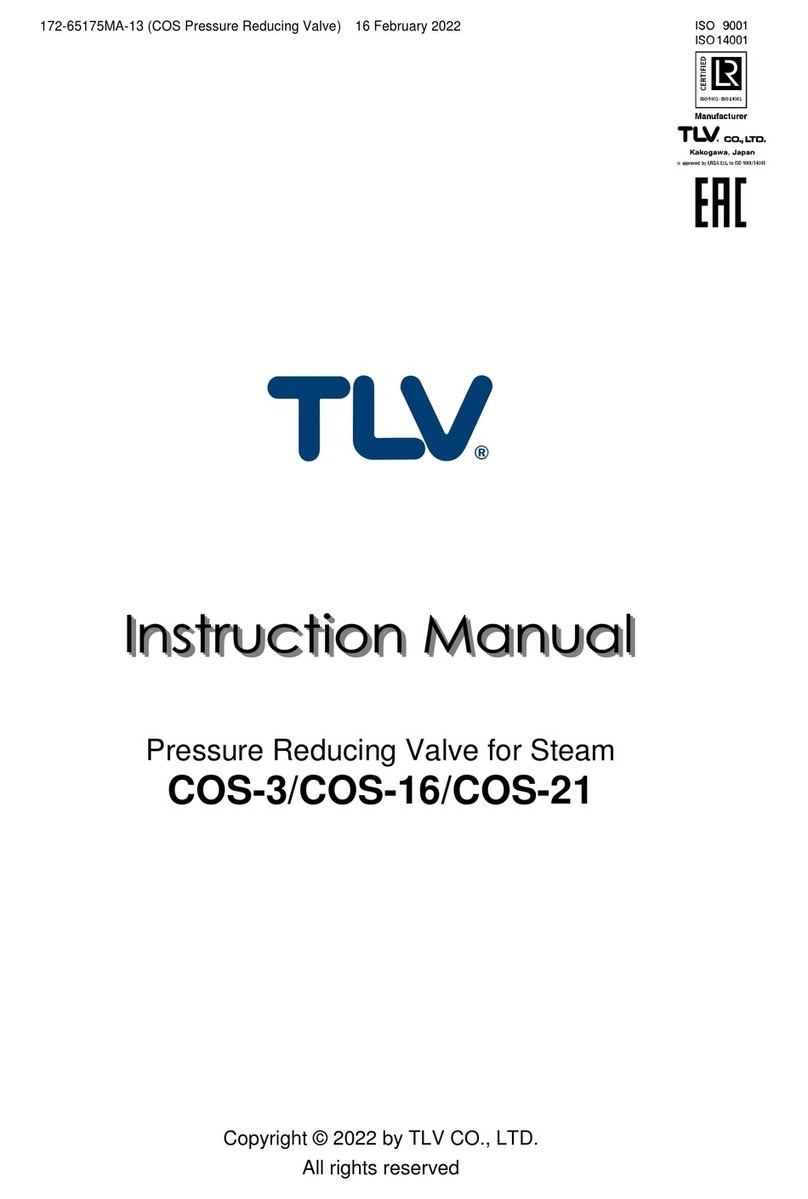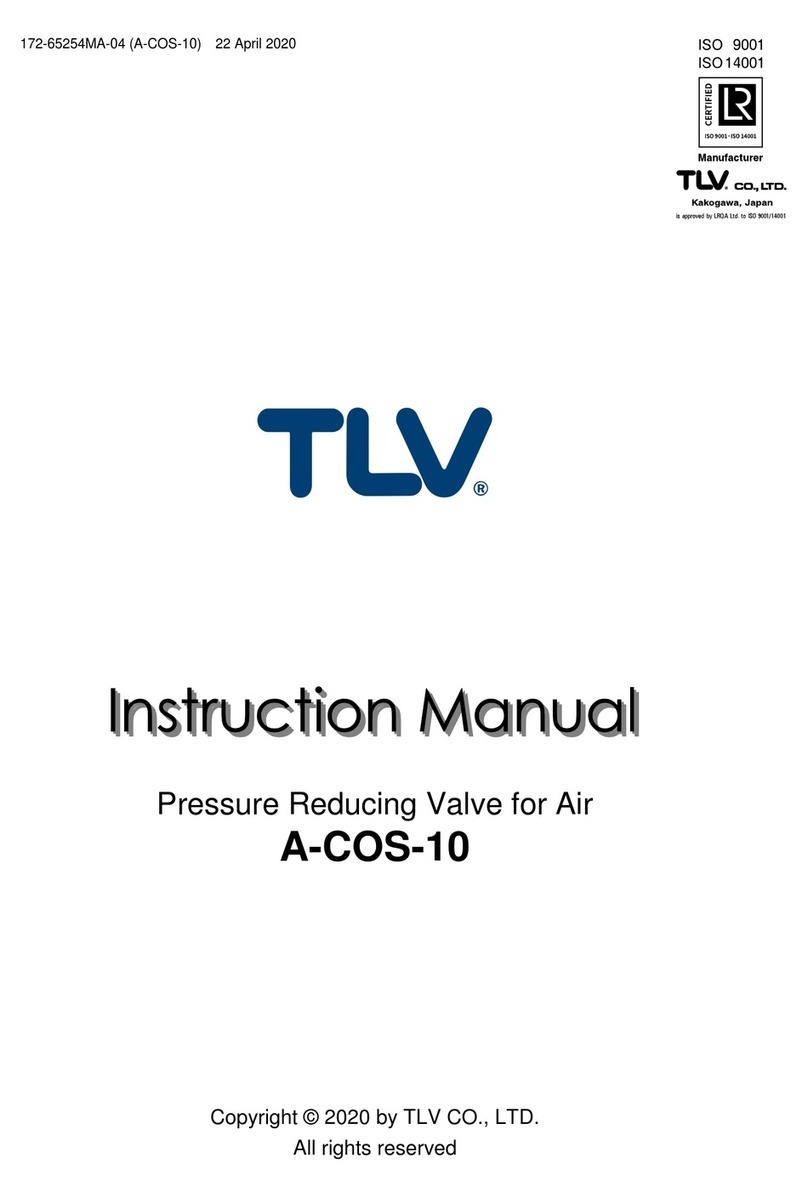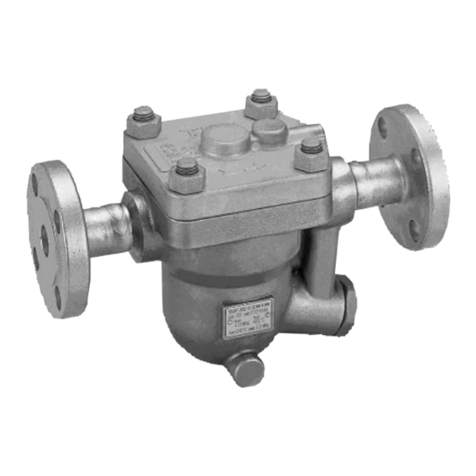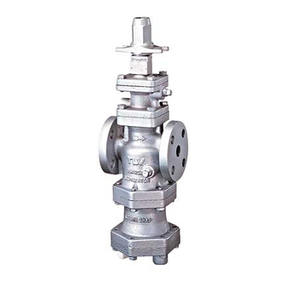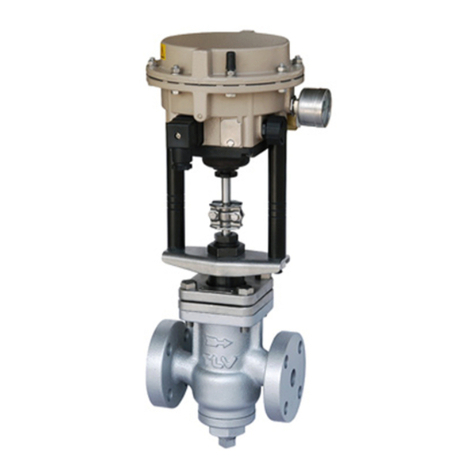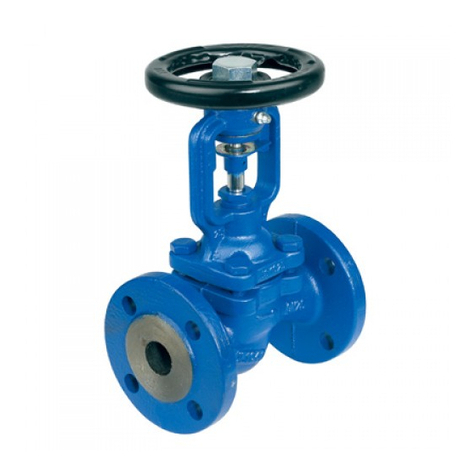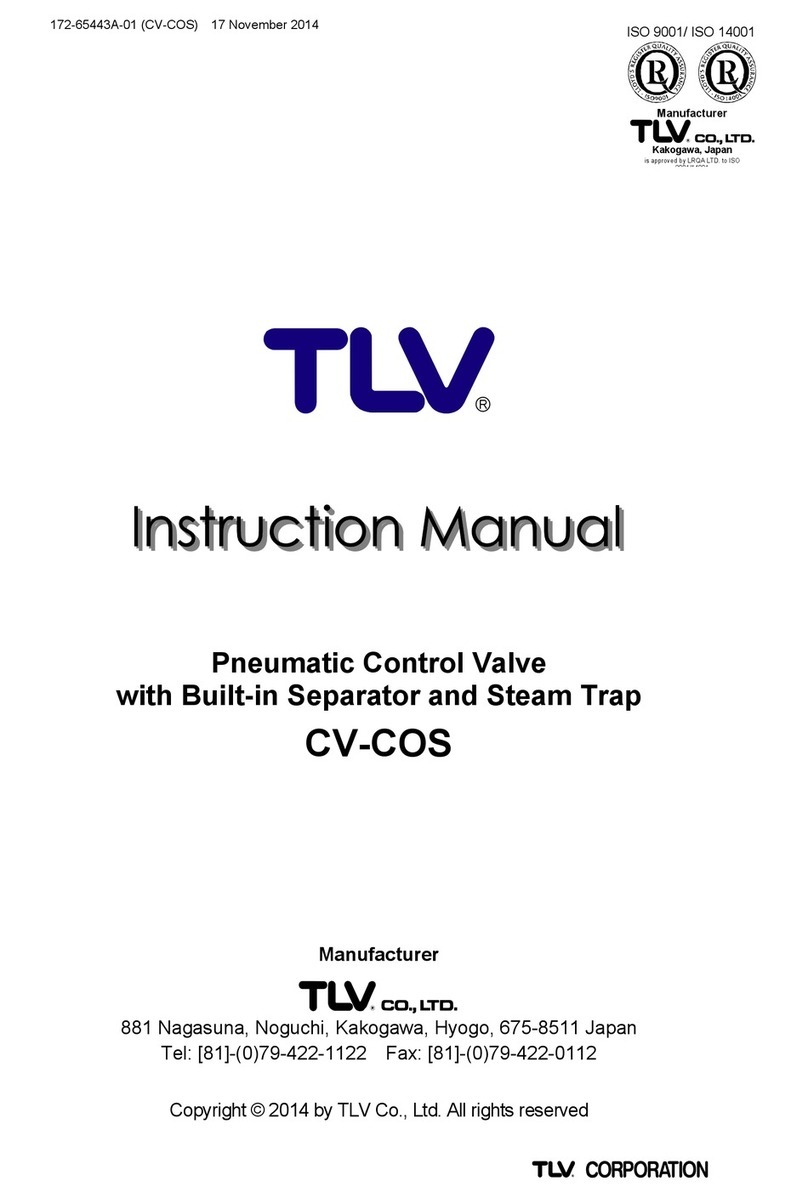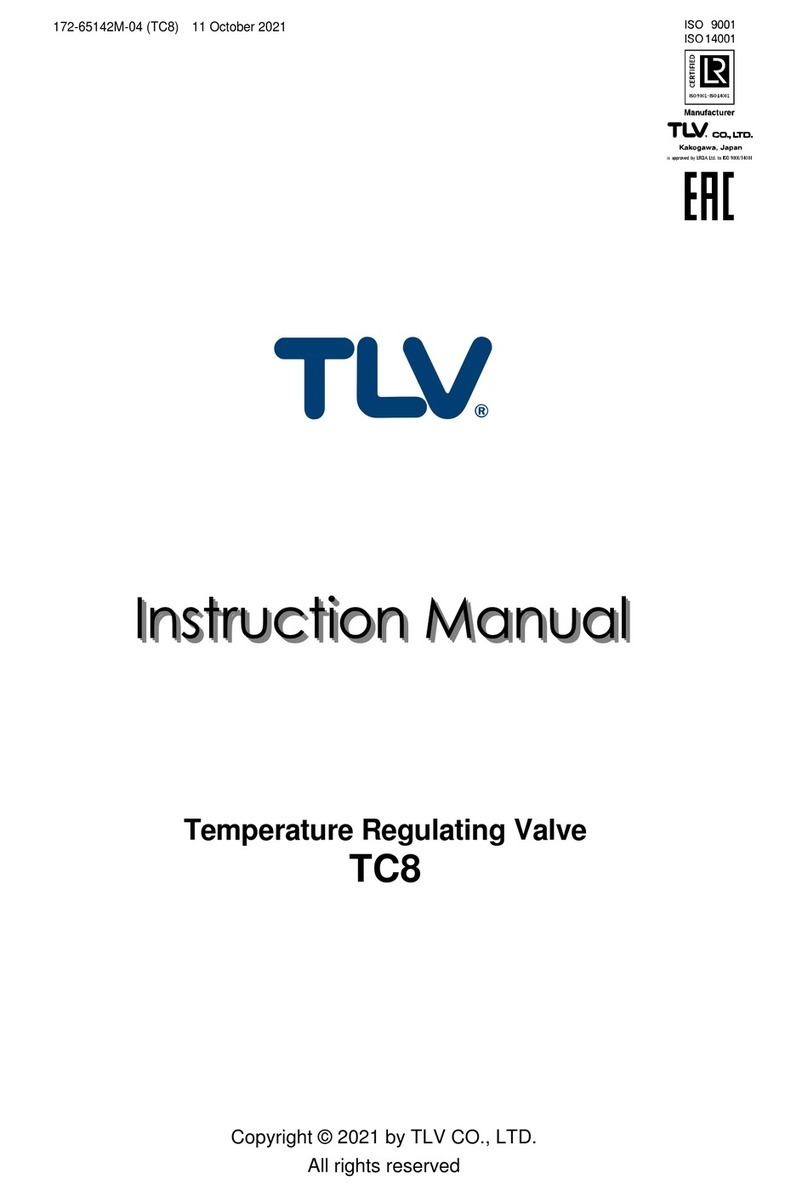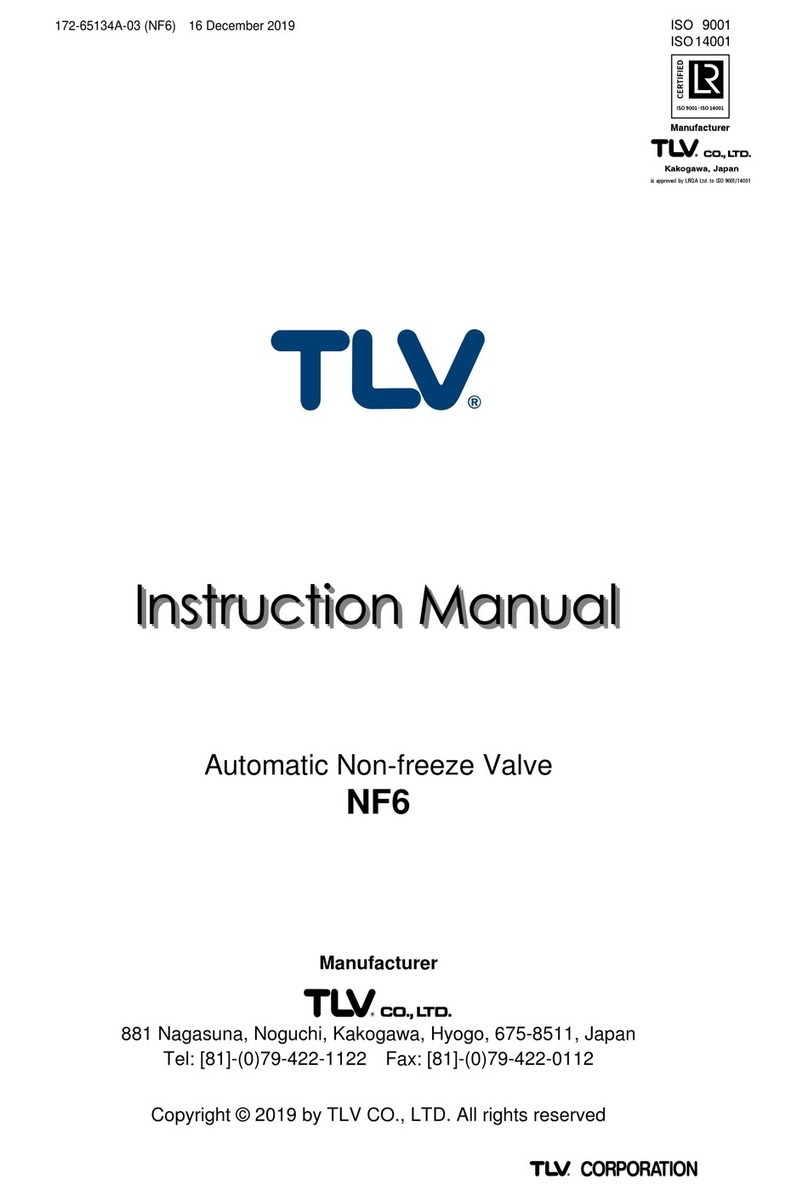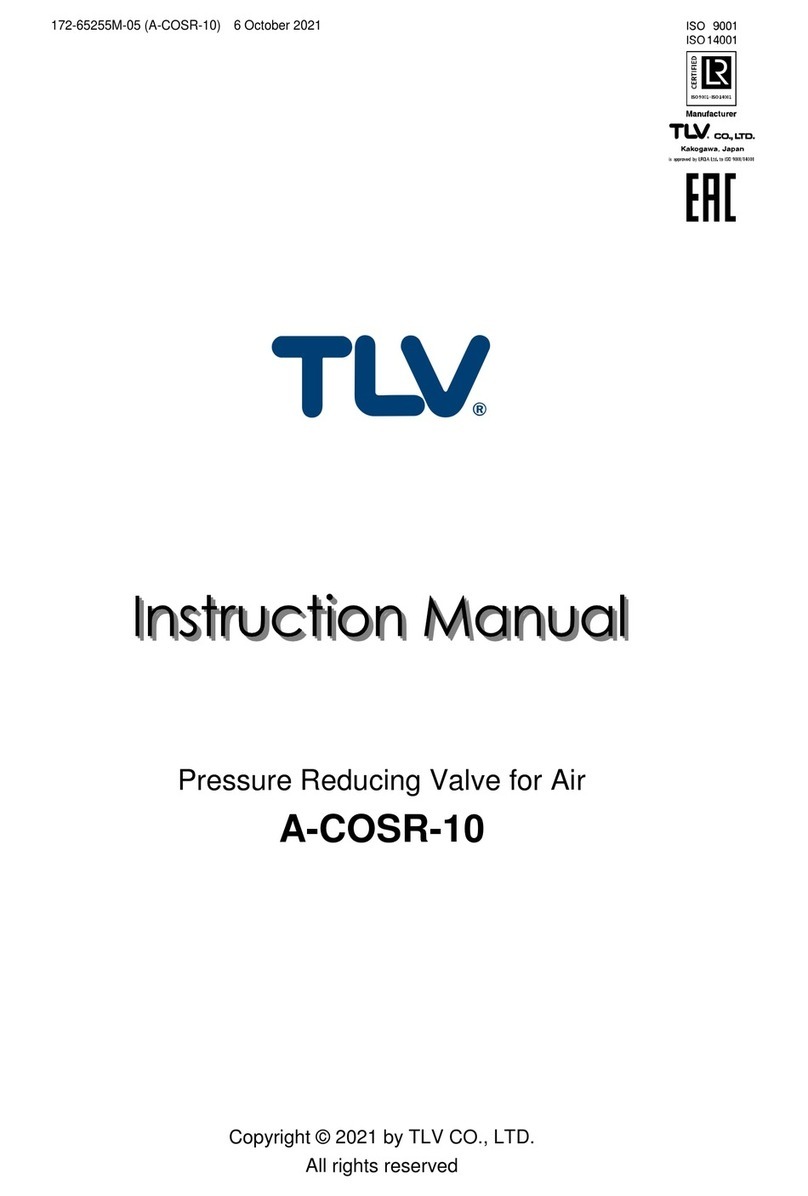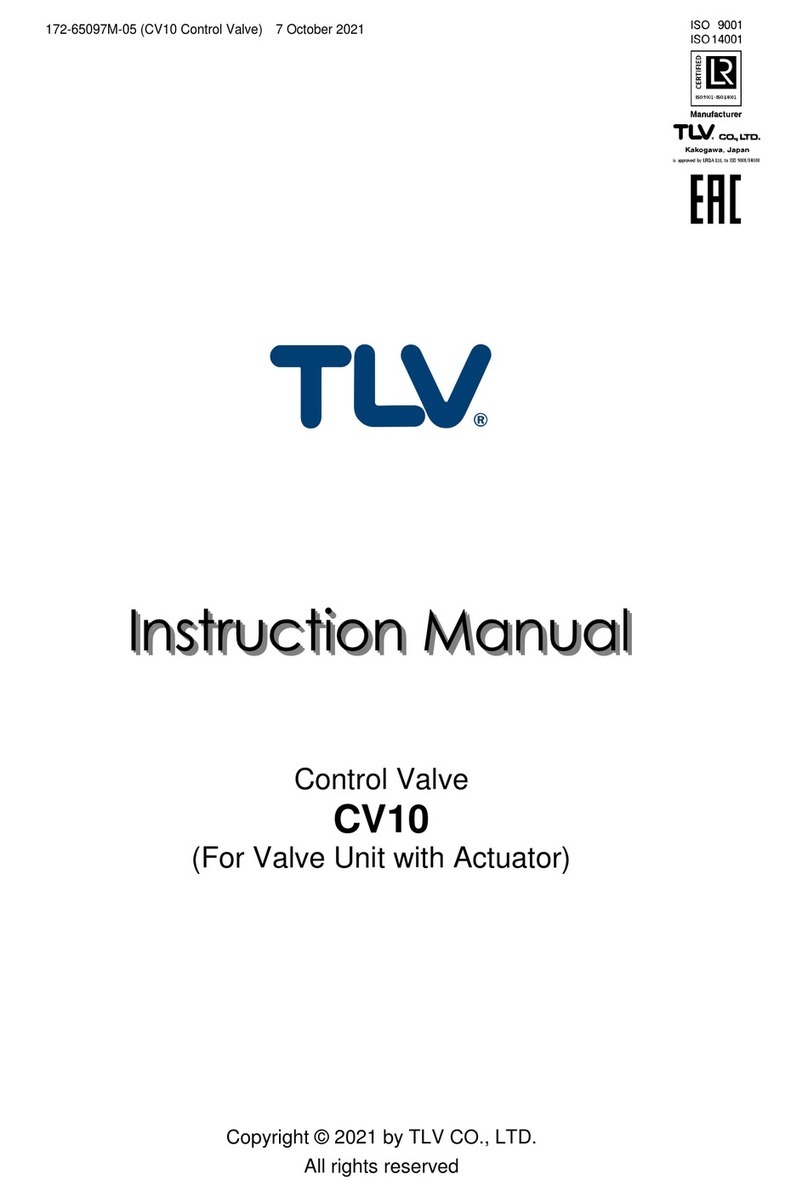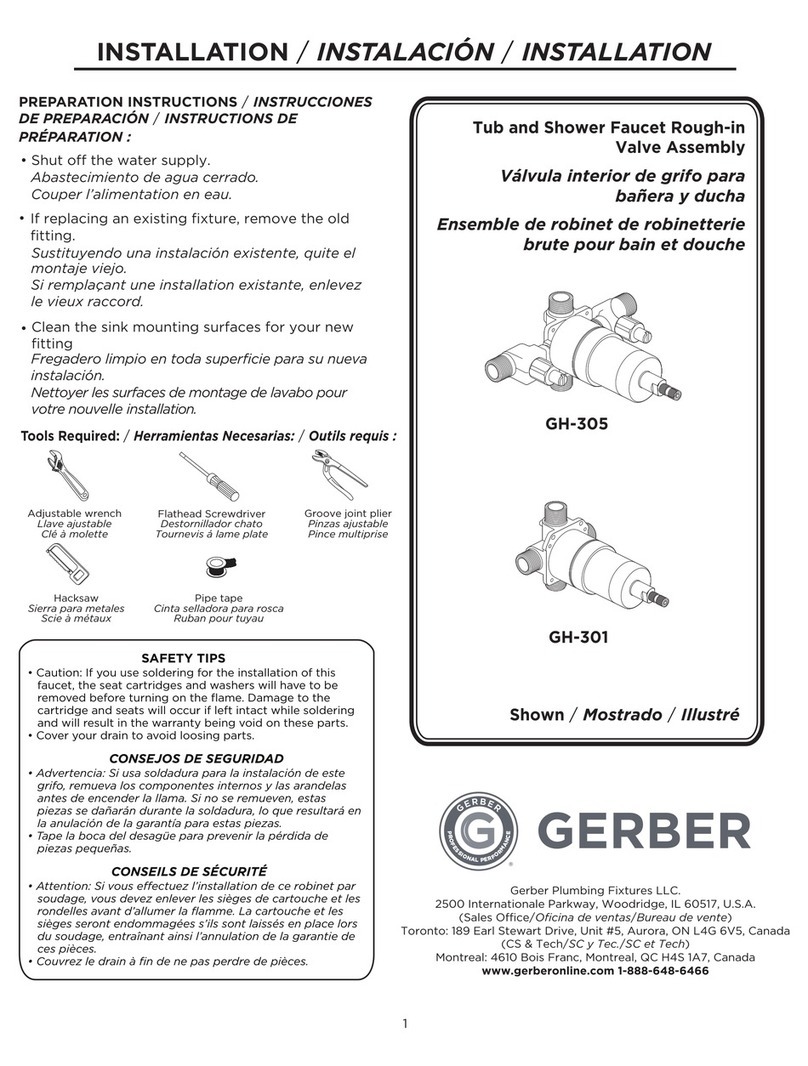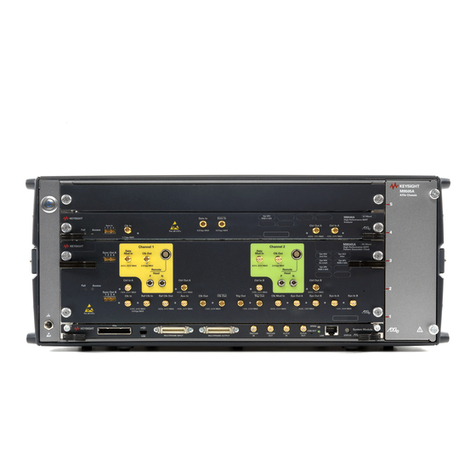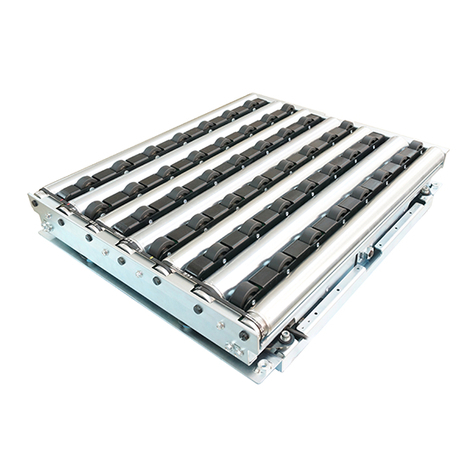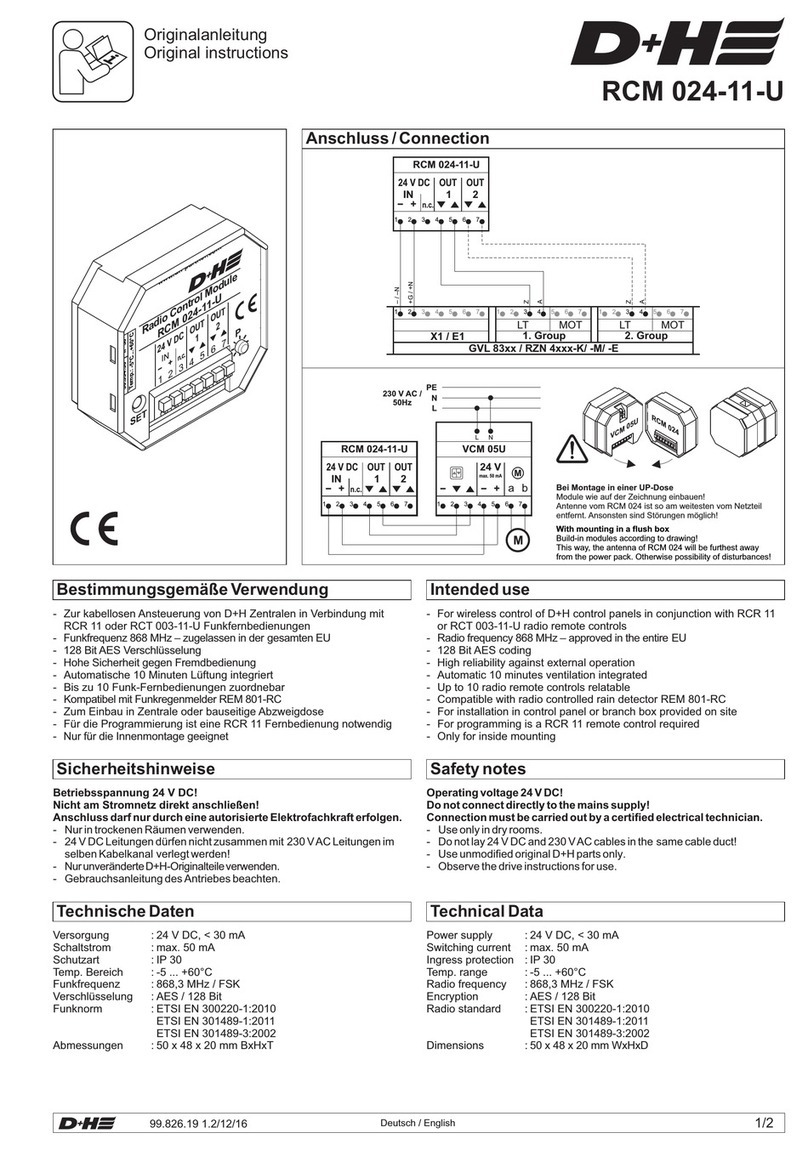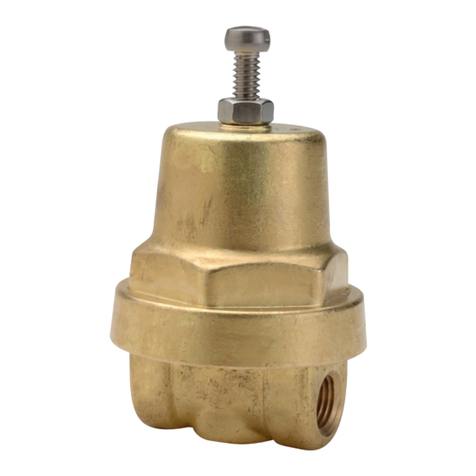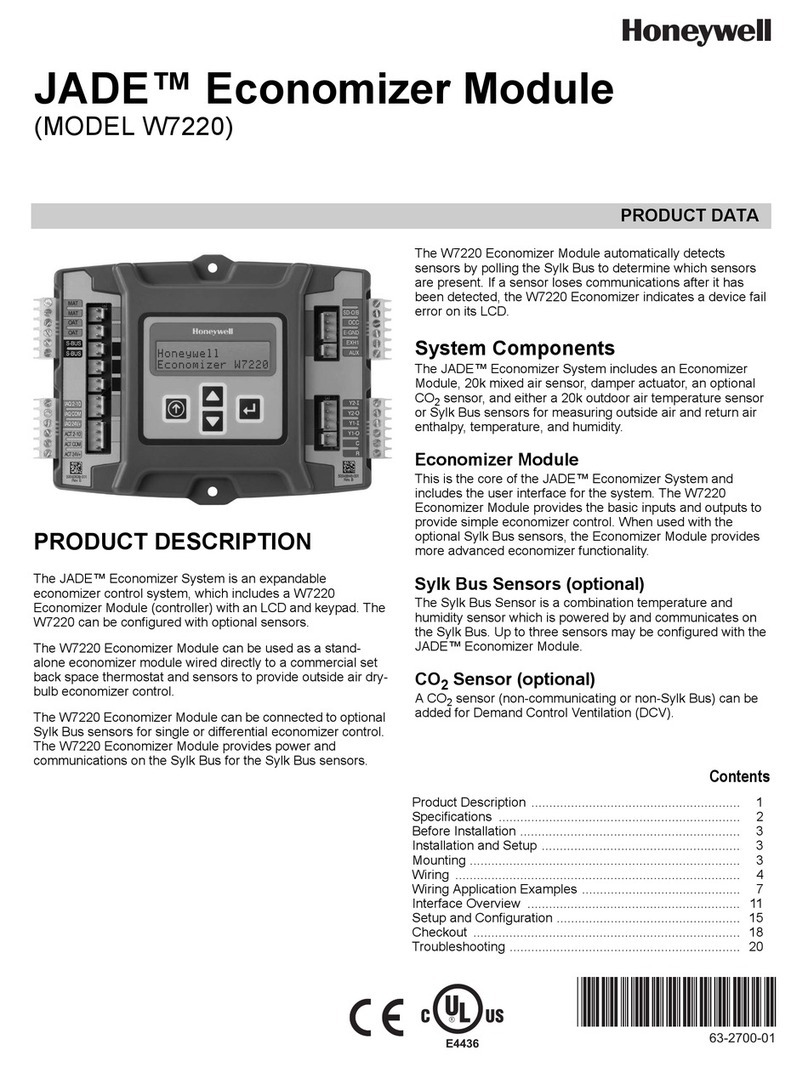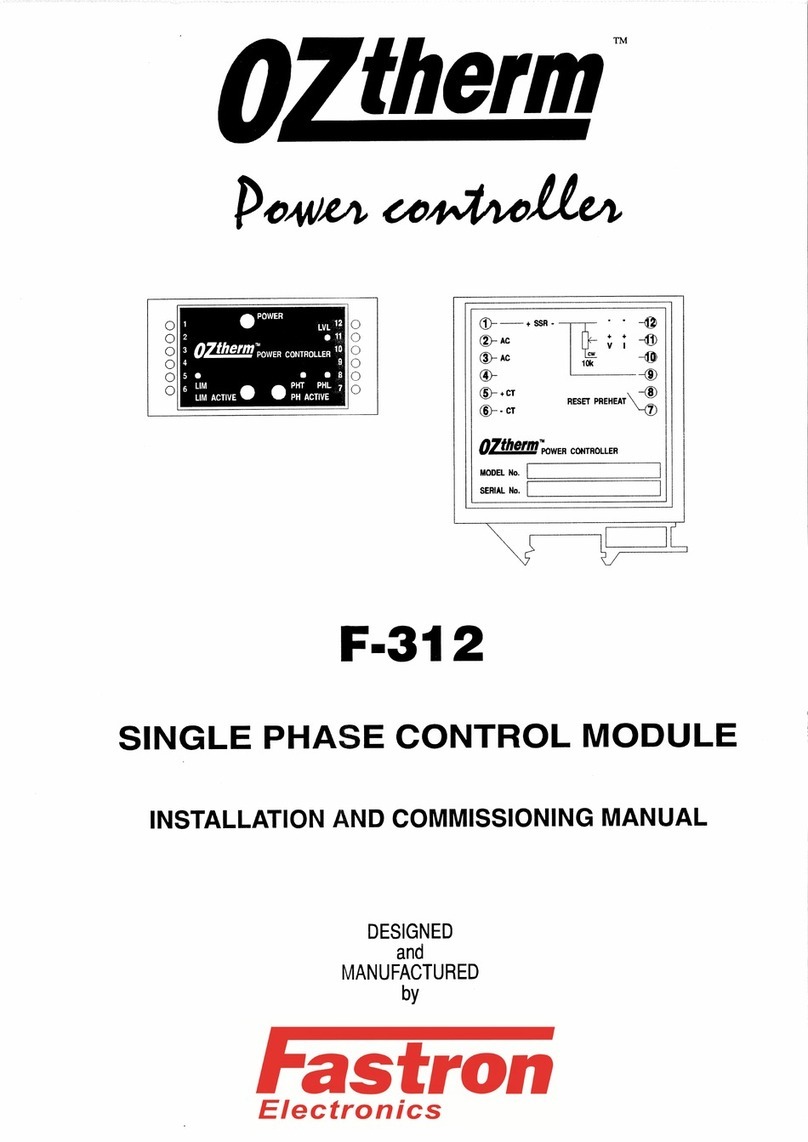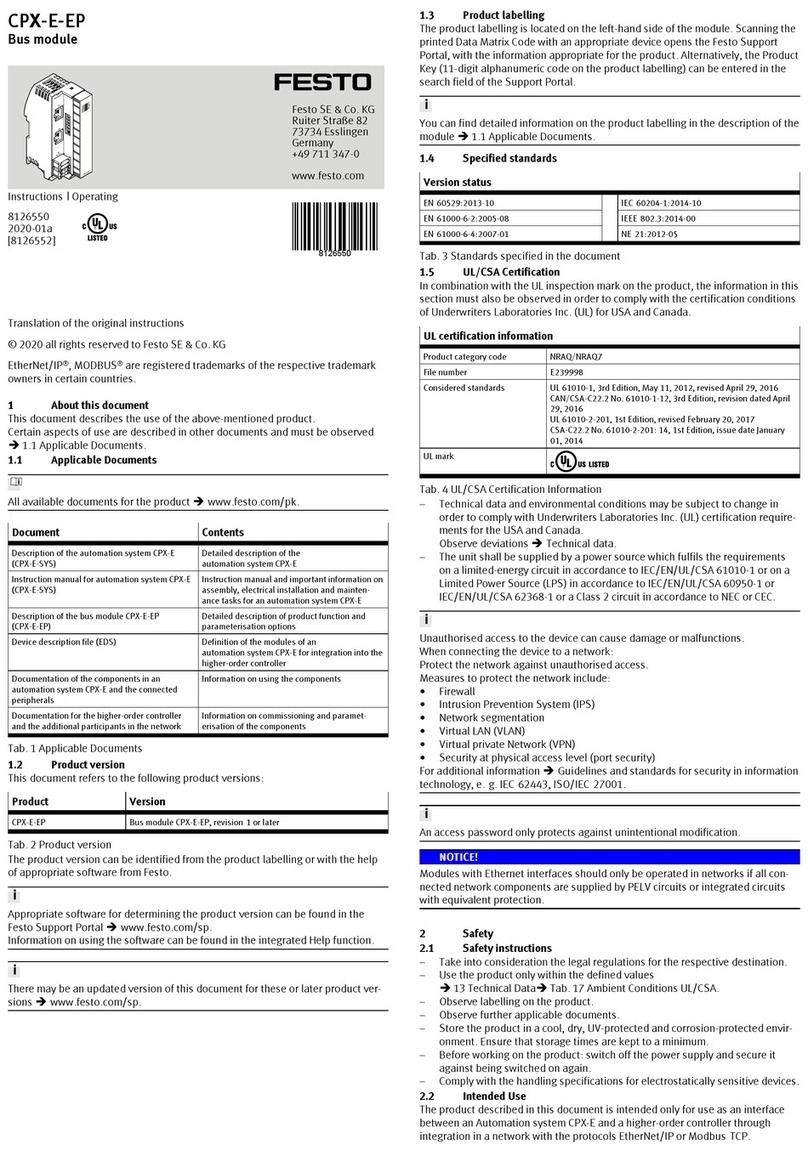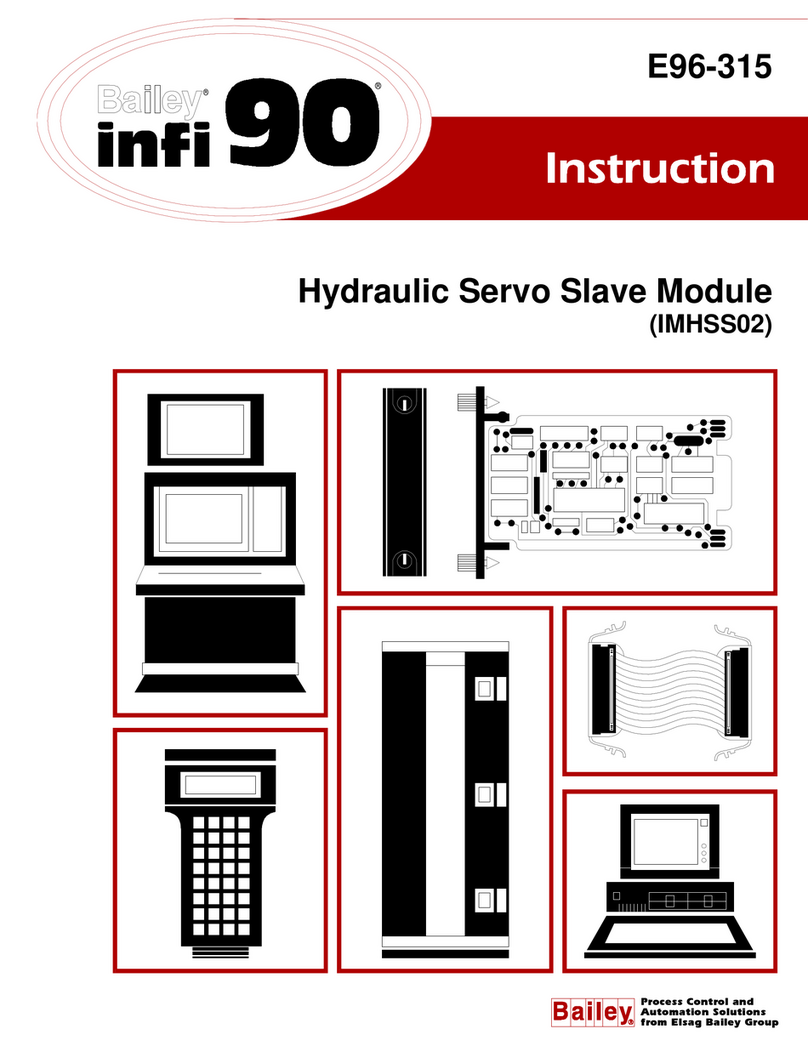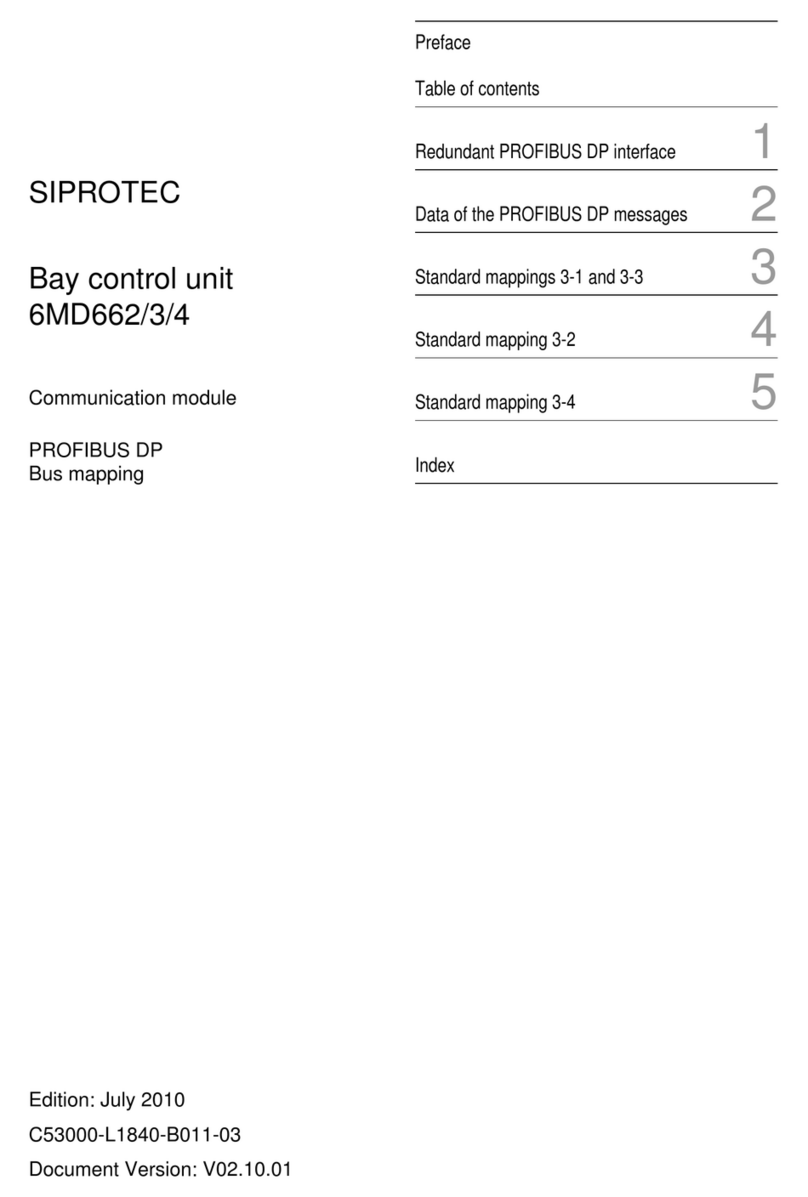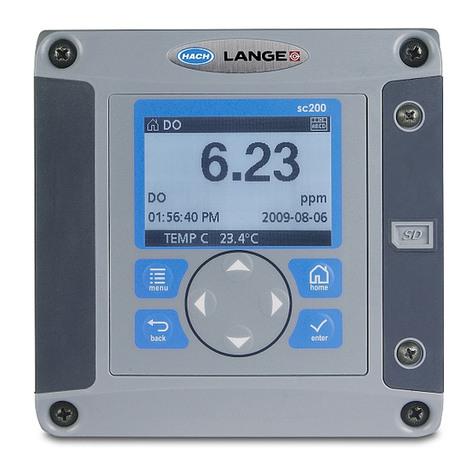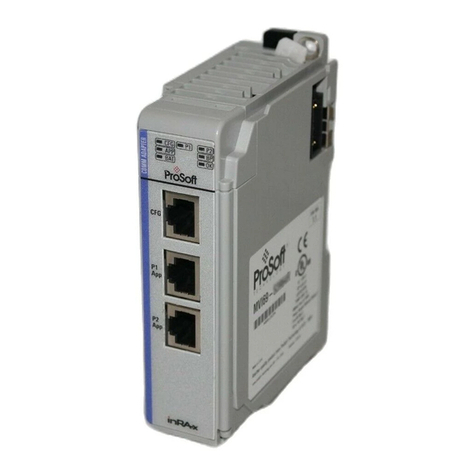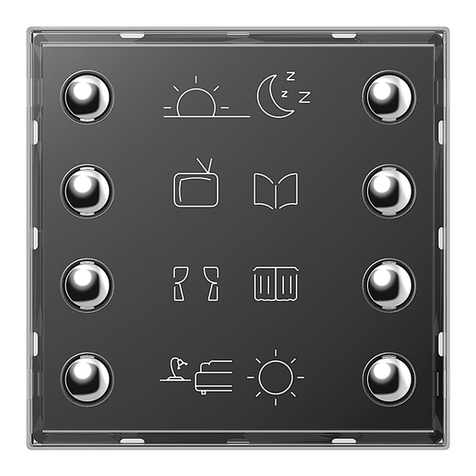TLV CV-COS-16 User manual

172-65727MA-01 (CV-COS-16) 7 October 2021
Electro-Pneumatic Control Valve
with Built-in Separator and Steam Trap
CV-COS-16
(for Valve Unit)
Copyright © 2021 by TLV CO., LTD.
All rights reserved

172-65727MA-01 (CV-COS-16) 7 Oct 2021
1
Contents
Introduction .......................................................................1
Safety Considerations.......................................................2
Specifications....................................................................4
Configuration.....................................................................5
Installation.........................................................................6
Maintenance......................................................................9
Disassembly/Reassembly...............................................10
Troubleshooting...............................................................17
TLV EXPRESS LIMITED WARRANTY...........................18
Service ............................................................................20
Options............................................................................21
Introduction
Thank you for purchasing the TLV electro-pneumatic control valve with built-in
separator and steam trap.
This product has been thoroughly inspected before being shipped from the
factory. When the product is delivered, before doing anything else, check the
specifications and external appearance to make sure nothing is out of the
ordinary. Also be sure to read this manual carefully before use and follow the
instructions to be sure of using the product properly.
The TLV electro-pneumatic control valve with built-in separator and steam
trap is a revolutionary product that combines a digital positioner, a diaphragm-
type actuator, a separator and a steam trap. Steam-using equipment can
achieve its intended efficiency only if the steam being used is very dry. Using
steam in which matter such as condensate, scale or types of grease is
entrained can not only result in problems with the steam-using equipment and
in lowered productivity, but can also lead to shortened service life for and
malfunction of the control valve. The CV-COS-16 is a new control valve that
offers a solution for these problems by supplying high-quality steam to the
process and offering maximum productivity.
If detailed instructions for special order specifications or options not contained
in this manual are required, please contact TLV for full details.
This instruction manual is intended for use with the model(s) listed on the
front cover. It is needed not only for installation, but also for subsequent
maintenance, disassembly/reassembly and troubleshooting. Please keep it in
a safe place for future reference.
For details of the actuator and the electro-pneumatic digital positioner, refer to
the respective instruction manuals issued by the manufacturer.

172-65727MA-01 (CV-COS-16) 7 Oct 2021
2
Safety Considerations
Read this section carefully before use and be sure to follow the instructions.
Installation, inspection, maintenance, repairs, disassembly, adjustment and valve
opening/closing should be carried out only by trained maintenance personnel.
The precautions listed in this manual are designed to ensure safety and prevent
equipment damage and personal injury. For situations that may occur as a result
of erroneous handling, three different types of cautionary items are used to
indicate the degree of urgency and the scale of potential damage and danger:
DANGER, WARNING and CAUTION.
The three types of cautionary items above are very important for safety: be sure
to observe all of them as they relate to installation, use, maintenance and repair.
Furthermore, TLV accepts no responsibility for any accidents or damage
occurring as a result of failure to observe these precautions.
Symbols
Indicates a DANGER, WARNING or CAUTION item.
Indicates an urgent situation which poses a threat of death or
serious injury
Indicates that there is a potential threat of death or serious injury
Indicates that there is a possibility of injury or equipment / product
damage
NEVER apply direct heat to the float.
The float may explode due to increased internal pressure, causing
accidents leading to serious injury or damage to property and
equipment.
Install properly and DO NOT use this product outside the
recommended operating pressure, temperature and other
specification ranges.
Improper use may result in such hazards as damage to the
product or malfunctions that may lead to serious accidents. Local
regulations may restrict the use of this product to below the
conditions quoted.
DO NOT use the product in excess of the maximum operating
pressure differential.
Such use could make discharge through the steam trap
impossible (blocked).
Use hoisting equipment for heavy objects (weighing
approximately 20 kg (44 lb) or more).
Failure to do so may result in back strain or other injury if the
object should fall.
Take measures to prevent people from coming into direct
contact with product outlets.
Failure to do so may result in burns or other injury from the
discharge of fluids.
Continued on the next page
DANGER
WARNING
CAUTION
WARNING
CAUTION

172-65727MA-01 (CV-COS-16) 7 Oct 2021
3
When disassembling or removing the product, wait until the
internal pressure equals atmospheric pressure and the
surface of the product has cooled to room temperature.
Disassembling or removing the product when it is hot or under
pressure may lead to discharge of fluids, causing burns, other
injuries or damage.
Be sure to use only the recommended components when
repairing the product, and NEVER attempt to modify the
product in any way.
Failure to observe these precautions may result in damage to the
product and burns or other injury due to malfunction or the
discharge of fluids.
Do not use excessive force when connecting threaded pipes
to the product.
Over-tightening may cause breakage leading to fluid discharge,
which may cause burns or other injury.
Use only under conditions in which no freeze-up will occur.
Freezing may damage the product, leading to fluid discharge,
which may cause burns or other injury.
Use only under conditions in which no water hammer will
occur.
The impact of water hammer may damage the product, leading to
fluid discharge, which may cause burns or other injury.
Make sure the power supply is OFF before carrying out work
on the wiring or inspections involving disassembly.
If such work is carried out with the power on, there is a danger
that equipment may malfunction or electric shock may occur,
leading to injury or other accidents.
Make sure that wiring work requiring a special license is
carried out by qualified personnel.
If carried out by unqualified personnel, overheating or short
circuits leading to injury, fires, damage or other accidents may
occur.
When using this product, NEVER stand close to, or leave
tools anywhere near, moving parts, such as the shaft.
Contact with moving parts or objects becoming caught in moving
parts could lead to injury or damage or other accidents.
CAUTION

172-65727MA-01 (CV-COS-16) 7 Oct 2021
4
Specifications
Install properly and DO NOT use this product outside the recommended
operating pressure, temperature and other specification ranges.
Improper use may result in such hazards as damage to the product or
malfunctions which may lead to serious accidents. Local regulations
may restrict the use of this product to below the conditions quoted.
CAUTION
DO NOT use the product in excess of the maximum operating pressure
differential; such use could make discharge impossible (blocked).
CAUTION
Use only under conditions in which no freeze-up will occur. Freezing
may damage the product, leading to fluid discharge, which may cause
burns or other injury.
CAUTION
Refer to the product nameplate*** for detailed specifications.
Valve Section
Actuator Section
*Maximum allowable pressure (PMA) and maximum allowable temperature (TMA) are
PRESSURE SHELL DESIGN CONDITIONS, NOT OPERATING CONDITIONS.
**Valve No. is displayed for products with options. This item is omitted from the
nameplate when there are no options.
***Nameplate layout depends on product specifications.
Model
NominalDiameter
Maximum Allowable*
Pressure*
Maximum Operating
Pressure
Maximum Allowable
Temperature (TMA)*
Maximum Operating
Temperature (TMO)
Valve No.**
Serial No.
Operating Direction
Model
NominalDiameter
Maximum Allowable
Pressure*
Maximum Operating
Pressure
Maximum Allowable
Temperature (TMA)*
Maximum Operating
Temperature (TMO)
Valve No.**
Serial No.
Spring Range Pressure supplied to
Positioner
Valve Material
Valve Characteristic
Stroke Cv Value

172-65727MA-01 (CV-COS-16) 7 Oct 2021
5
Configuration
*Replacement parts are available only in
the following kits:
A = Maintenance Kit
B = Repair Kit
C = Repair Kit for Trap Valve Seat
D = Float
No.
Part Name
A*
B*
C*
D*
1
Main Body
2
Separator Body
3
Trap Cover
4
Flange
5
Guide Bushing
6
Valve Bonnet Nut
7
Valve Bonnet
8
Stuffing Box V-ring
Packing
9
Stuffing Box Washer
10
Stuffing Box Spring
11
Valve Plug & Stem
12
Valve Bonnet Gasket
13
Bolt
14
Nut
15
Main Valve Seat
16
Separator Screen
17
Separator
18
Wave Spring
19
Valve Seat Gasket
20
Separator Body Bolt
21
Float Cover
22
Float
23
Float Cover Bolt
24
Spring Washer
25
Trap Cover Gasket
26
Trap Valve Seat Gasket
27
Trap Valve Seat
28
Trap Cover Bolt
29
Nameplate

172-65727MA-01 (CV-COS-16) 7 Oct 2021
6
Installation
Install properly and DO NOT use this product outside the recommended
operating pressure, temperature and other specification ranges.
Improper use may result in such hazards as damage to the product or
malfunctions which may lead to serious accidents. Local regulations
may restrict the use of this product to below the conditions quoted.
CAUTION
Use hoisting equipment for heavy objects (weighing approximately
20 kg (44 lb) or more). Failure to do so may result in back strain or other
injury if the object should fall.
CAUTION
Take measures to prevent people from coming into direct contact with
product outlets. Failure to do so may result in burns or other injury from
the discharge of fluids.
CAUTION
Do not use excessive force when connecting threaded pipes to the
product. Over-tightening may cause breakage leading to fluid
discharge, which may cause burns or other injury.
CAUTION
Installation, inspection, maintenance, repairs, disassembly and adjustment and valve
opening/closing should be carried out only by trained maintenance personnel.
Check to make sure that the piping where the product is to be installed is constructed
properly. If the piping is not correctly constructed, the valve may not perform optimally.
1. Blowdown
Before installing the product, be sure to blow down all piping thoroughly.
If this is not possible, perform a blowdown using the bypass valve. Blowdown
is especially important for newly installed piping or after the system has been
shut down for a long period of time.
2. Removing any Protective Caps and Seals
Before installation, be sure to remove all protective seals and caps.
(Found in 3 locations, on the product inlet and outlets.)
3. Installation Angle
Install the product so that the arrow mark on the body
points horizontally in the direction of steam flow, and it
should be installed horizontally in the piping with the
actuator at the top. Allowable inclination is 10 degrees in
the fore-aft direction and 15 degrees in the plane
perpendicular to the steam flow line.
4. Piping Support
Install the product, paying attention to avoid excessive load,
bending and vibration. Support the inlet and outlet pipes
securely.
① ②
③

172-65727MA-01 (CV-COS-16) 7 Oct 2021
7
5. Maintenance Space
Leave sufficient space for maintenance, inspection and
repair. (Units: mm) 100 mm ≈4"
110 mm ≈41/2"
300 mm ≈12"
400 mm ≈16"
6. Trap Outlet Pipe
For ease of maintenance, installation of a union
connection is recommended for the trap outlet pipe.
Connect the outlet pipe to a condensate return line, or
extend it to a trench. In the case of the latter, make sure
the end of the pipe is above the waterline. (Dirt and
water may be sucked up by the vacuum formed during
trap closure and system shutdown.) If the end must be
underwater, make sure the piping has a small hole, as shown in the drawing
below.
7. Accessories
Always install a shut-off valve, pressure gauge and bypass lines at both inlet and
outlet. Ball valves, which will not retain condensate, are recommended for inlet
and outlet shut-off valves. The bypass pipe should be at least 1/2 of the size of
the inlet (primary side) pipe.
8. Installation Environment
Check the installation environment to make sure that the ambient temperature
does not exceed the actuator ambient temperature limit and that no corrosive
gasses are present.
9. Shut-off Valve Installation
Though the product adequately performs the function of a shut-off valve initially,
extended use will result in a drop in its performance as an isolation valve. Be sure
to install a separate shut-off or automatic valve if complete isolation is needed.
10. Safety Valve Installation
When installing a safety valve, be sure not to install it between the control valve
and the shut-off valve
It must be installed near the equipment it is to protect, on the outlet side of the
shut-off valve.
Safety Valve
Safety Valve
Small hole
15 mm
(1/2in)

172-65727MA-01 (CV-COS-16) 7 Oct 2021
8
11. Avoid Foreign Matter and Water Hammer
Do not install in locations in the piping where foreign matter accumulates or
where impact from water pressure (water hammer) occurs.
12. Piping Gaskets
Be careful that the piping gaskets do not protrude outside the inner bore of the
flange.
The type of medium being used and the temperature must be taken into account
in order to select a gasket of a suitable material.
13. Air Line Blowdown/Purge
Before connecting the air lines for the motive air that is to be piped to the
actuator, blow out the air in the lines to purge any dirt, foreign matter, oil or water
from inside of the piping.
14. Quality of Motive Air
Supply to the actuator only clean air that does not contain water, oil or foreign
matter.
To prevent malfunction due to contamination of the air supply, installation of the
optional air filter regulator (5 µm filter) and mist separator (0.3 µm filter) as a set
is recommended.
If air quality results in operation failure, the entire actuator unit (including the
integrated positioner) must be replaced.
If there is a problem in operation, determine the cause using the “Troubleshooting”
section in this manual.

172-65727MA-01 (CV-COS-16) 7 Oct 2021
9
Maintenance
Take measures to prevent people from coming into direct contact with
product outlets. Failure to do so may result in burns or other injury from
the discharge of fluids.
CAUTION
When disassembling or removing the product, wait until the internal
pressure equals atmospheric pressure and the surface of the product
has cooled to room temperature. Disassembling or removing the
product when it is hot or under pressure may lead to discharge of fluids,
causing burns, other injuries or damage.
CAUTION
Be sure to use only the recommended components when repairing the
product, and NEVER attempt to modify the product in any way. Failure to
observe these precautions may result in damage to the product or burns
or other injury due to malfunction or the discharge of fluids.
CAUTION
Operational Check
An inspection of the following items should be done on a daily basis to determine
whether the product is operating properly or has failed. Periodically (at least
biannually) the operation should also be checked.
In the event of failure (malfunction), also refer to the "Troubleshooting" section for
remedies.
Inspection Item
Inspection Points
Remedy for Failure (Malfunction)
Leakage from valve
(when the valve is
closed)
Visual inspection or stethoscope
inspection; is the outlet side pressure
or temperature elevated, or is there
the sound of the medium flowing?
Adjust the zero/span; if that does
not solve the problem, replace
with a new valve plug & stem
and valve seat
Leakage from gland
area
Visual inspection; is fluid leaking
from the gap between the guide
bushing and the valve stem, or
are there signs it has leaked
previously?
Coat the guide bushing and the
valve stem with grease; if that
does not solve the problem,
replace with new V-ring packing
Leakage from the
gaskets between
any pressurized
parts
Visual inspection; is fluid leaking
from the gasket areas on
pressurized parts?
Apply additional tightening (refer
to recommended torque) or
replace with new gaskets
Leakage from
pressurized parts
such as body and
valve bonnet
Visual inspection; is fluid leaking
from pressurized parts such as
the body or valve bonnet?
Replace any pressurized parts at
leak locations
Leakage from the
trap area
Visual inspection or stethoscope
inspection; is live steam being
discharged from the trap outlet
piping, or can the sound of a
steam leak be heard?
Clean the sealing surface of the
trap valve seat or replace the
valve seat
Parts Inspection
When parts have been removed, use the following table to inspect the parts and
replace any that are found to be defective.
Inspection Item
Gasket(s): Check for warping and damage (Graphite gaskets MUST be replaced if disassembled)
Stuffing Box V-ring Packing: Check for warping or damage
Valve Plug & Stem, Valve Seat: Check for damage or scratches
Separator screen: Check for clogging and corrosion
Trap Valve Seat: Check for scratches, dents, etc.
Float: Check for scratches, dents, etc.

172-65727MA-01 (CV-COS-16) 7 Oct 2021
10
Disassembly/Reassembly
When disassembling or removing the product, wait until the internal
pressure equals atmospheric pressure and the surface of the product
has cooled to room temperature. Disassembling or removing the
product when it is hot or under pressure may lead to discharge of fluids,
causing burns, other injuries or damage.
CAUTION
Be sure to use only the recommended components when repairing the
product, and NEVER attempt to modify the product in any way. Failure to
observe these precautions may result in damage to the product or burns
or other injury due to malfunction or the discharge of fluids.
CAUTION
Use the following procedures to remove components. Use the same procedures in
reverse to reassemble. (Installation, inspection, maintenance, repairs, disassembly,
adjustment and valve opening/closing should be carried out only by trained
maintenance personnel.)
Refer to “Disassembling/Reassembling the Valve and Actuator Sections” on the
following page when removing the actuator section.
Consult the table of tightening torques when mounting the actuator section on the
valve section.
NOTE: Be sure to coat all threaded portions of the valve seat and bolts with anti-seize.
Removing/Reattaching the Stem Bracket Clamps
Part
During Disassembly
During Reassembly
—
Set the actuator air supply pressure
to 0 MPaG (0 psig) to maintain the
valve in the fully closed position.
Set the actuator air supply pressure
to 0 MPaG (0 psig) to maintain the
valve in the fully closed position.
Check to make sure the valve stem
and actuator stem are in firm
contact with each other.
Stem Bracket
Bolts
Remove with a socket wrench
Consult the table of tightening
torques and tighten to the proper
torque
Stem Bracket
Clamps
Take the bracket apart (separates
into 2 clamps)
After aligning the clamps, tighten the
nuts and bolts while making sure the
gap between the plates is even on
both sides
NOTE: Be careful not to pinch your fingers between the valve stem and actuator stem!
Single Bracket
Stem Bracket
Bolt
Stem Bracket
Clamps

172-65727MA-01 (CV-COS-16) 7 Oct 2021
11
Disassembling/Reassembling the Valve and Actuator Sections
Perform the following procedure before beginning disassembly:
1. After connecting the air piping, operate the air pressure reducing valve to maintain
the positioner air supply pressure at 0.38 MPaG (54 psig).
2. Connect a current generator or a controller for an operation signal input of 4 to 20
mA.
3. Switch the positioner/actuator to manual mode to separate the valve from the
actuator. See the instruction manual for the positioner and actuator for details.
Part
During Disassembly
During Reassembly
—
Set the operation signal input to 12 mA
(50%)
Make sure the gap between the valve
stem and the actuator stem is open
Set the operation signal input to 12
mA (50%)
Make sure the gap between the valve
stem and the actuator stem is open
Valve
Bonnet Nut
Remove with an open-end wrench
Consult the table of tightening torques
and tighten to the proper torque
NOTE: Be careful not to pinch your fingers between the valve stem and actuator stem!
Disassembling/Reassembling of the Body Section
Part
During Disassembly
During Reassembly
Guide Bushing
Loosen slightly with a socket wrench
to make the following procedure
easier
Consult the table of tightening
torques and tighten to the proper
torque
Nuts for flange
Remove with a socket wrench
Tighten the nuts evenly, while
checking to make sure that there is
no catching or biting when the valve
plug is seated in the valve seat; after
tightening to the rated torque, check
to make sure that the valve plug &
stem moves up and down smoothly;
make sure to tighten them evenly
Continued on the next page
Valve Bonnet
Nut
The actuator unit
orientation can
be changed.

172-65727MA-01 (CV-COS-16) 7 Oct 2021
12
Part
During Disassembly
During Reassembly
Flange/
Valve Bonnet
Pull up and off, being careful not to
damage the valve plug & stem or
valve seat
Reattach, being careful not to
damage the valve plug & stem or
valve seat
Insert the valve bonnet into the
gasket housing securely and without
tilting
Valve Bonnet
Gasket
Remove the gasket and clean
sealing surfaces
Replace with a new gasket; do not
coat with anti-seize
Valve Bonnet
Guide
Pull up and off, taking care not to
damage the valve plug & stem or
valve seat
The difference between the inner
diameter of the body and the outer
diameter of the valve bonnet guide is
very small, so make sure that it does
not tilt and get caught when pulling
the valve bonnet guide up and off
Reattach, being careful not to
damage the valve plug & stem or
valve seat
The difference between the inner
diameter of the body and the outer
diameter of the valve bonnet guide
is very small, so make sure that it
does not tilt and get caught when
inserting the valve bonnet guide
Valve Bonnet
Guide Gasket
Remove the gasket and clean
sealing surfaces
Replace with a new gasket if warped
or damaged
Valve Plug &
Stem
Pull up and out, being careful not to
damage the plug & stem
Reattach, being careful not to
damage the plug & stem
Valve Seat
15 to 25 mm (1/2to 1 in): Remove
with a socket wrench
40 to 50 mm (11/2to 2 in): Remove
with a thin wall socket fitted to a
socket wrench or a power wrench;
when using a power wrench, refer to
its instruction manual
Overtightening the valve seat may
lead to damage the valve seat
and/or body; consult the table of
tightening torques and tighten to the
proper torque
Valve Seat
Gasket
Remove the gasket and clean
sealing surfaces
Replace with a new gasket if warped
or damaged
Valve Seat
Valve Plug & Stem
Valve Bonnet
Gasket
Flange
Nut
Valve
Bonnet
Guide
Bushing

172-65727MA-01 (CV-COS-16) 7 Oct 2021
13
Removing/Reattaching the Separator and its Components
Part
During Disassembly
During Reassembly
Bolts for the
Main and
Separator
Body
Remove with a socket wrench
When lifting the main body, be careful
not to let the separator fall out
Consult the table of tightening
torques and tighten to the proper
torque
Separator
Screen
Remove the separator screen
Being careful not to bend it, insert it
securely onto the slanted part of the
separator
Separator
Remove the separator
Insert it into the groove in the main
body
Wave Spring
Remove the wave spring
Insert it into the groove in the trap body
Wave Spring
Separator Body Bolt
Screen
Separator
Valve Seat
Gasket
Separator

172-65727MA-01 (CV-COS-16) 7 Oct 2021
14
Removing/Reattaching the Trap and its Components
Part
During Disassembly
During Reassembly
Bolts for Trap
Cover/Float
Cover Bolt &
Spring Washers
Remove with a socket wrench
Consult the table of tightening
torques and tighten to the proper
torque
Float Cover
Pull up and off
Replace with a new float cover
Float
Take care not to scratch or misshape
the surface of the float
Take care not to scratch or
misshape the surface of the float
Trap Valve
Seat
Remove with a socket wrench
Consult the table of tightening torques
and tighten to the proper torque
Trap Valve Seat
Gasket
Remove the gasket and clean
sealing surfaces
Replace with a new gasket if warped
or damaged
Trap Cover
Gasket
Remove the gasket and clean
sealing surfaces
Replace with a new gasket if warped
or damaged
Disassembling/Reassembling the Gland and its Components
In the procedure below, first partially loosen the guide bushing and then remove the
valve plug & stem before removing the other parts. (The procedure is most easily
performed if the bushing is loosened while it is attached to the valve body.)
Part
During Disassembly
During Reassembly
Guide Bushing
Remove with a
socket wrench
Consult the table of tightening torques and
tighten to the proper torque
Stuffing Box V-Ring
Packing
Pull up and out
Make sure to reassemble the V-ring
packing in the proper orientation; coat the
groove with heat-resistant silicon grease;
reattach the V-ring packing with the
grooves facing downward
Stuffing Box Washer/
Stuffing Box Spring
Pull up and out
Reinsert
Separator Body
Trap Cover Bolt
Float Cover Bolt
Spring Washer
Float
Trap Cover Gasket
Trap Valve Seat
Trap Valve Seat
Gasket
Float Cover
Guide
Bushing
Stuffing Box
Washer
Stuffing Box
Spring
Valve Bonnet
Stuffing Box
V-ring Packing
BLK
BLK
WHT
BLK
BLK
Sectional View of
Stuffing Box
V-ring Packing

172-65727MA-01 (CV-COS-16) 7 Oct 2021
15
Table of Tightening Torques
Size
Torque
Distance Across
Flats
mm
(in)
N·m
(lbf·ft)
mm
(in)
Guide Bushing
15 to 50
(1/2to 2)
50
(37)
24
(15/16)
Nuts for Flange
15 to 25
(1/2to 2)
40
(29)
16
(5/8)
17
(21/32)
40, 50
(11/2to 2)
50
(37)
18
(11/16)
19
(3/4)
Valve Seat
15 to 25
(1/2to 2)
170
(124)
27
(11/16)
40, 50
(11/2to 2)
500
(185)
55
(25/32)
Separator Body Bolt
15 to 40
(1/2to 11/2)
60
(44)
16
(5/8)
17
(21/32)
50
(2)
70
(51)
18
(11/16)
19
(3/4)
Float Cover Bolt
15 to 20
(1/2to 3/4)
7
(5.1)
8
(5/16)
25 to 40
(1 to 11/2)
10
(7)
10
(3/8)
50
(2)
20
(15)
13
(1/2)
14
(9/16)
Trap Valve Seat
15 to 20
(1/2to 3/4)
10
(7)
11
(7/16)
25 to 40
(1 to 11/2)
15
(11)
13
(1/2)
14
(9/16)
50
(2)
40
(29)
16
(5/8)
17
(21/32)
Trap Cover Bolt
15 to 40
(1/2to 11/2)
60
(44)
16
(5/8)
17
(21/32)
50
(2)
70
(51)
18
(11/16)
19
(3/4)
Valve Bonnet Nut
15 to 50
(1/2to 2)
150
(72)
36
(113/32)
Stem Bracket Bolt
15 to 50
(1/2to 2)
5
(4)
8
(5/16)
NOTE:
-Coat all threaded portions with anti-seize.
-If drawings or other special documentation were supplied for the
product, any torque given there takes precedence over values
shown here.
(1 Nm 10 kgcm)

172-65727MA-01 (CV-COS-16) 7 Oct 2021
16
Exploded View
Valve Bonnet Nut
Nut
Flange
Stuffing Box V-ring Packing
Stuffing Box Washer
Stuffing Box Spring
Valve Bonnet Valve Bonnet Gasket
Valve Plug & Stem
Valve Seat
Bolt
Main Body
Separator Screen
Separator
Wave Spring
Valve Seat Gasket
Separator Body
Separator Body Bolt
Float Cover
Trap Valve Seat Gasket
Float
Trap Cover Gasket
Trap Cover
Trap Cover Bolt
Trap Valve Seat Gasket
Nameplate
Front: Model, size,
date of manufacture
Back: Spring range,
Cv value, etc.
(The shape of the plug differs depend on the
size and the Cv value
Guide Bushing

172-65727MA-01 (CV-COS-16) 7 Oct 2021
17
Troubleshooting
When disassembling or removing the product, wait until the internal
pressure equals atmospheric pressure and the surface of the product
has cooled to room temperature. Disassembling or removing the
product when it is hot or under pressure may lead to discharge of fluids,
causing burns, other injuries or damage.
CAUTION
When the valve unit fails to operate properly, use the following table to locate the
cause and remedy. When the actuator and positioner fail to operate properly, refer
to the applicable manual.
Valve Section
Problem
Cause
Diagnosis
Remedy (Countermeasure)
Valve Leakage
The pressure of the air
supply to the actuator
or positioner is too
high
Check the pressure of
the air supply to the
actuator and positioner
(confirm product
specifications on the
nameplate)
Adjust the pressure of the
air supply for the positioner
to match the pressure in the
product specifications
Refer to the instruction
manual for the positioner
for zero point adjustment
The positioner’s zero
point is miscalibrated
Check the actuator air
supply pressure (on
the positioner’s
pressure gauge) when
the operation signal is
at zero point
If the pressure on the
pressure gauge is elevated,
adjust the positioner’s zero
point (refer to the instruction
manual for positioner)
The inlet pressure for
the control valve is too
high
Check the inlet
pressure for the control
valve
Decrease the inlet pressure
(Cv value and the spring
range must be changed)
The valve plug and
valve seat are off-
center
Move the valve plug &
stem up and down and
check to see if it catches
Reassemble the valve
bonnet section correctly
Wear of the sealing
surfaces of the valve
plug and valve seat
Check the valve plug
and valve seat
Replace the valve plug and
valve seat.
Consider replacing with a
valve plug and valve seat of
a more durable material.
Steam Trap Section
Problem
Cause
Diagnosis
Remedy (Countermeasure)
Steam is
blowing
There is a build-up of
dirt on the trap valve
seat or on the float
Check the trap valve
seat and the float
Clean or replace with a new
trap valve seat or float
The body is installed
tilted
Check the installation
conditions
Correct the installation
The float is deformed
Check the float
Replace with a new float
(Inspect for water hammer
or freezing)
There is vibration in
the piping
Check the piping
conditions
Remove the source of the
vibration or reinforce the
piping supports
No condensate
is discharged
The primary pressure
exceeds the trap
valve seat maximum
working pressure
Check the primary
pressure
Decrease the inlet pressure
to the maximum operating
pressure (PMO) or less
Water is inside the
float
Check the float
Replace with a new float
(Investigate to see if the
flow medium contains
corrosive substances)
Output piping is clogged
Check the outlet piping
Clean or modify the piping
The trap valve seat is
clogged
Check the trap valve
seat
Clean or replace with a new
trap valve seat

172-65727MA-01 (CV-COS-16) 7 Oct 2021
18
TLV EXPRESS LIMITED WARRANTY
Subject to the limitations set forth below, TLV CO., LTD., a Japanese corporation
(“TLV”), warrants that products which are sold by it, TLV International Inc. (“TII”) or
one of its group companies excluding TLV Corporation (a corporation of the United
States of America), (hereinafter the “Products”) are designed and manufactured by
TLV, conform to the specifications published by TLV for the corresponding part
numbers (the “Specifications”) and are free from defective workmanship and
materials. The party from whom the Products were purchased shall be known
hereinafter as the “Seller”. With regard to products or components manufactured by
unrelated third parties (the “Components”), TLV provides no warranty other than the
warranty from the third party manufacturer(s), if any.
Exceptions to Warranty
This warranty does not cover defects or failures caused by:
1. improper shipping, installation, use, handling, etc., by persons other than TLV,
TII or TLV group company personnel, or service representatives authorized by
TLV; or
2. dirt, scale or rust, etc.; or
3. improper disassembly and reassembly, or inadequate inspection and
maintenance by persons other than TLV or TLV group company personnel, or
service representatives authorized by TLV; or
4. disasters or forces of nature or Acts of God; or
5. abuse, abnormal use, accidents or any other cause beyond the control of TLV,
TII or TLV group companies; or
6. improper storage, maintenance or repair; or
7. operation of the Products not in accordance with instructions issued with the
Products or with accepted industry practices; or
8. use for a purpose or in a manner for which the Products were not intended; or
9. use of the Products in a manner inconsistent with the Specifications; or
10. use of the Products with Hazardous Fluids (fluids other than steam, air, water,
nitrogen, carbon dioxide and inert gases (helium, neon, argon, krypton, xenon
and radon)); or
11. failure to follow the instructions contained in the TLV Instruction Manual for the
Product.
Duration of Warranty
This warranty is effective for a period of one (1) year after delivery of Products to the
first end user. Notwithstanding the foregoing, asserting a claim under this warranty
must be brought within three (3) years after the date of delivery to the initial buyer if
not sold initially to the first end user.
ANY IMPLIED WARRANTIES NOT NEGATED HEREBY WHICH MAY ARISE BY
OPERATION OF LAW, INCLUDING THE IMPLIED WARRANTIES OF MERCHANTABILITY
AND FITNESS FOR A PARTICULAR PURPOSE AND ANY EXPRESS WARRANTIES NOT
NEGATED HEREBY, ARE GIVEN SOLELY TO THE INITIAL BUYER AND ARE LIMITED IN
DURATION TO ONE (1) YEAR FROM THE DATE OF SHIPMENT BY THE SELLER.
Exclusive Remedy
THE EXCLUSIVE REMEDY UNDER THIS WARRANTY, UNDER ANY EXPRESS
WARRANTY OR UNDER ANY IMPLIED WARRANTIES NOT NEGATED HEREBY
(INCLUDING THE IMPLIED WARRANTIES OF MERCHANTABILITY AND FITNESS FOR A
PARTICULAR PURPOSE), IS REPLACEMENT; PROVIDED: (a) THE CLAIMED DEFECT IS

172-65727MA-01 (CV-COS-16) 7 Oct 2021
19
REPORTED TO THE SELLER IN WRITING WITHIN THE WARRANTY PERIOD, INCLUDING
A DETAILED WRITTEN DESCRIPTION OF THE CLAIMED DEFECT AND HOW AND WHEN
THE CLAIMED DEFECTIVE PRODUCT WAS USED; AND (b) THE CLAIMED DEFECTIVE
PRODUCT AND A COPY OF THE PURCHASE INVOICE IS RETURNED TO THE SELLER,
FREIGHT AND TRANSPORTATION COSTS PREPAID, UNDER A RETURN MATERIAL
AUTHORIZATION AND TRACKING NUMBER ISSUED BY THE SELLER. ALL LABOR
COSTS, SHIPPING COSTS, AND TRANSPORTATION COSTS ASSOCIATED WITH THE
RETURN OR REPLACEMENT OF THE CLAIMED DEFECTIVE PRODUCT ARE SOLELY
THE RESPONSIBILITY OF BUYER OR THE FIRST END USER. THE SELLER RESERVES
THE RIGHT TO INSPECT ON THE FIRST END USER’S SITE ANY PRODUCTS CLAIMED
TO BE DEFECTIVE BEFORE ISSUING A RETURN MATERIAL AUTHORIZATION. SHOULD
SUCH INSPECTION REVEAL, IN THE SELLER’S REASONABLE DISCRETION, THAT THE
CLAIMED DEFECT IS NOT COVERED BY THIS WARRANTY, THE PARTY ASSERTING
THIS WARRANTY SHALL PAY THE SELLER FOR THE TIME AND EXPENSES RELATED
TO SUCH ON-SITE INSPECTION.
Exclusion of Consequential and Incidental Damages
IT IS SPECIFICALLY ACKNOWLEDGED THAT THIS WARRANTY, ANY OTHER EXPRESS
WARRANTY NOT NEGATED HEREBY, AND ANY IMPLIED WARRANTY NOT NEGATED
HEREBY, INCLUDING THE IMPLIED WARRANTIES OF MERCHANTABILITY AND FITNESS
FOR A PARTICULAR PURPOSE, DO NOT COVER, AND NEITHER TLV, TII NOR ITS TLV
GROUP COMPANIES WILL IN ANY EVENT BE LIABLE FOR, INCIDENTAL OR
CONSEQUENTIAL DAMAGES, INCLUDING, BUT NOT LIMITED TO LOST PROFITS, THE
COST OF DISASSEMBLY AND SHIPMENT OF THE DEFECTIVE PRODUCT, INJURY TO
OTHER PROPERTY, DAMAGE TO BUYER’S OR THE FIRST END USER’S PRODUCT,
DAMAGE TO BUYER’S OR THE FIRST END USER’S PROCESSES, LOSS OF USE, OR
OTHER COMMERCIAL LOSSES. WHERE, DUE TO OPERATION OF LAW,
CONSEQUENTIAL AND INCIDENTAL DAMAGES UNDER THIS WARRANTY, UNDER ANY
OTHER EXPRESS WARRANTY NOT NEGATED HEREBY OR UNDER ANY IMPLIED
WARRANTY NOT NEGATED HEREBY (INCLUDING THE IMPLIED WARRANTIES OF
MERCHANTABILITY AND FITNESS FOR A PARTICULAR PURPOSE) CANNOT BE
EXCLUDED, SUCH DAMAGES ARE EXPRESSLY LIMITED IN AMOUNT TO THE
PURCHASE PRICE OF THE DEFECTIVE PRODUCT. THIS EXCLUSION OF
CONSEQUENTIAL AND INCIDENTAL DAMAGES, AND THE PROVISION OF THIS
WARRANTY LIMITING REMEDIES HEREUNDER TO REPLACEMENT, ARE INDEPENDENT
PROVISIONS, AND ANY DETERMINATION THAT THE LIMITATION OF REMEDIES FAILS
OF ITS ESSENTIAL PURPOSE OR ANY OTHER DETERMINATION THAT EITHER OF THE
ABOVE REMEDIES IS UNENFORCEABLE, SHALL NOT BE CONSTRUED TO MAKE THE
OTHER PROVISIONS UNENFORCEABLE.
Exclusion of Other Warranties
THIS WARRANTY IS IN LIEU OF ALL OTHER WARRANTIES, EXPRESS OR IMPLIED,
AND ALL OTHER WARRANTIES, INCLUDING BUT NOT LIMITED TO THE IMPLIED
WARRANTIES OF MERCHANTABILITY AND FITNESS FOR A PARTICULAR PURPOSE,
ARE EXPRESSLY DISCLAIMED.
Severability
Any provision of this warranty which is invalid, prohibited or unenforceable in any
jurisdiction shall, as to such jurisdiction, be ineffective to the extent of such invalidity,
prohibition or unenforceability without invalidating the remaining provisions hereof,
and any such invalidity, prohibition or unenforceability in any such jurisdiction shall
not invalidate or render unenforceable such provision in any other jurisdiction.
Table of contents
Other TLV Control Unit manuals



